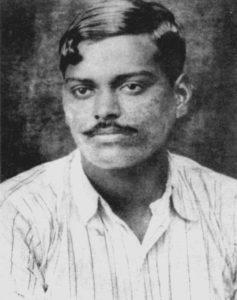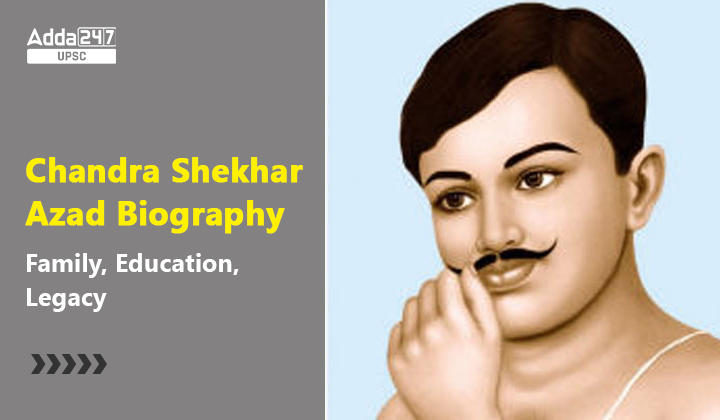Table of Contents
Chandra Shekhar Azad, originally Chandra Shekhar Tiwari, emerged as a prominent Indian revolutionary leader and freedom fighter. After the death of the Hindustan Republican Association (HRA) founder Ram Prasad Bismil, Azad played a crucial role in reorganizing the group into the Hindustan Socialist Republican Association (HSRA). Alongside key members like Roshan Singh, Rajendra Nath Lahiri, and Ashfaqulla Khan, Azad, often using the pseudonym “Balraj,” signed pamphlets as the leader of HSRA.
Chandra Shekhar Azad Biography
- Chandra Shekhar Azad, born on July 23, 1906, in Bhavra, present-day Madhya Pradesh, India, was a prominent revolutionary and freedom fighter in the Indian independence movement. From an early age, Azad displayed a fervent commitment to the cause of liberating India from British colonial rule. He was deeply influenced by the Jallianwala Bagh massacre in 1919 and actively participated in various protests and movements.

- Chandra Shekhar Azad joined the Hindustan Socialist Republican Association (HSRA) in 1928, aligning himself with revolutionaries like Bhagat Singh.
- He played a pivotal role in executing acts of resistance against British oppression, notably participating in the Kakori Train Robbery and the Central Assembly bombing.
- Azad’s chosen alias, meaning “immortal,” symbolized his unwavering determination, as he famously declared his resolve never to be captured alive by the British authorities.
- Tragically, he met his end in a heroic confrontation with the police at Alfred Park, Allahabad, on February 27, 1931, at the tender age of 24.
- Chandra Shekhar Azad’s legacy endures as a testament to courage, sacrifice, and unyielding commitment to India’s struggle for freedom.
| Chandra Shekhar Azad Biography | |
| Particulars | Details |
| Date of Birth | July 23, 1906 |
| Birth Place of Chandra Shekhar Azad | Bhavra village in Madhya Pradesh |
| Chandra Shekhar Azad’s Parents |
His father Sitaram Tiwari was a gardener, while his mother Jagrani Devi was a homemaker.
|
| Original Name of Chandra Shekhar Azad | Chandra Shekhar Tiwari (After joining the movement, he was arrested by the British police and when he was presented before a magistrate, he declared his name to be ‘Azad’, his father’s name as ‘Swatantra’, and his residence as ‘prison’.) |
| Revolutionary Organisation he was associated with | Hindustan Republican Association (HRA) |
| Revolutionary Activities he was involved | Kakori Train Robbery on August 9, 1925 The shooting of JP Saunders at Lahore in 1928 |
| Death of Chandra Shekhar Azad |
He died at Azad Park in Allahabad on 27th February 1931.
|
Chandra Shekhar Azad’s Family
Chandra Shekhar Azad took his first breath in Bhabhra village, nestled in the Alirajpur princely state of Madhya Pradesh, India, on July 23, 1906. He was the cherished and solitary son of Sitaram Tiwari, renowned for his expertise in Sanskrit, and Jagrani Devi, a dedicated homemaker. His family included a younger brother named Sukhdev.

- Sitaram Tiwari: Sitaram Tiwari was a Sanskrit scholar and a teacher. He was a strict disciplinarian and he instilled in his son a strong sense of duty and morality. He was also a nationalist and he supported the Indian independence movement.
- Jagrani Devi: Jagrani Devi was a homemaker and a devout Hindu. She was a strong supporter of her son’s revolutionary activities and she often helped him to evade the police. She was also a great influence on his life and she taught him the importance of education and social justice.
- Sukhdev: Sukhdev was Chandra Shekhar Azad’s younger brother. He was also a revolutionary and he was executed by the British in 1931.
Chandra Shekhar Azad was profoundly influenced by his family. He inherited his father’s passion for learning and his mother’s dedication to social justice. Additionally, he drew inspiration from his brother’s involvement in revolutionary activities. Azad’s family played a pivotal role in shaping his life and his unwavering commitment to the Indian independence movement.
Beyond his immediate family, Azad also held a close relationship with his uncle, Pandit Madan Mohan Malviya, a prominent nationalist leader. Malviya’s influence greatly inspired Azad and strengthened his resolve in the struggle for independence.
Azad’s family and friends played a major role in his life and his revolutionary activities. They were a source of strength and support, and they helped to shape him into the great leader that he became.
Chandra Shekhar Azad’s Contribution to the Freedom Movement
Chandra Shekhar Azad rose as a prominent figure in India’s quest for independence. His steadfast patriotism and courageous deeds ignited the fervor of his peers, encouraging them to join the independence movement actively. Serving as a mentor to Bhagat Singh, Azad played a pivotal role in shaping the course of the struggle for freedom. Together, they are revered as two of India’s most illustrious revolutionaries. Delve into Azad’s invaluable contributions to the freedom movement below.
Non-Cooperation Movement
Chandra Shekhar Azad’s participation in the Non-Cooperation Movement mirrored his resolute dedication to India’s struggle for independence. Embracing Mahatma Gandhi’s principles, he zealously boycotted British institutions and goods, stirring national awareness through impassioned orations. While the movement upheld nonviolence, Azad, driven by mounting frustration, underscored the necessity of armed resistance alongside peaceful protest. His pivotal role in the movement exemplified his steadfast commitment and adaptive strategies, serving as a beacon of inspiration for generations in India’s pursuit of freedom.
Hindustan Republican Association
- After Gandhi suspended non-cooperation in 1922, Chandra Shekhar Azad joined the Hindustan Revolutionary Association (HRA), an Indian revolutionary group formed in 1924 by Sachindra Nath Sanyal, Narendra Mohan Sen, and Pratul Ganguly in East Bengal.
- Prominent members of HRA included Bhagat Singh, Chandra Shekhar Azad, Sukhdev, Ram Prasad Bismil, Roshan Singh, Ashfaqulla Khan, and Rajendra Lahiri.
- To fund revolutionary activities, the HRA orchestrated the Kakori Train Robbery near Lucknow in 1925, obtaining funds through thefts from government buildings.
- Chandra Shekhar Azad, Ram Prasad Bismil, Ashfaqulla Khan, Rajendra Lahiri, and Manmathnath Gupta were instrumental in executing the Kakori Conspiracy strategy.
Hindustan Socialist Republican Association
Established in 1928, under the leadership of Chandra Shekhar Azad, the Hindustan Socialist Republican Association (HSRA) emerged as a revolutionary entity committed to securing India’s liberation from British rule. Employing a blend of intellectual discourse and militant tactics, the HSRA sought to forge a cohesive resistance against British oppression. Azad’s guidance and the HSRA’s notable exploits, including the Kakori Train Robbery, etched a profound legacy of bravery and resolve in India’s struggle for independence. Despite its brief existence, the HSRA profoundly influenced a generation of freedom fighters, leaving an indelible mark on the trajectory of India’s freedom movement.
HSRA and Assassination of Saunders
In September 1928, Chandra Shekhar Azad, Bhagat Singh, and Sukhdev came together to establish the Hindustan Socialist Republican Association (HSRA). Following Lala Lajpat Rai’s tragic demise, the HSRA’s initial objective was to seek retribution by assassinating JP Saunders in Lahore in the same year. Another significant action was the bombing of the Central Assembly, undertaken as a protest against the Public Safety Bill and the Trade Disputes Bill.
Legacy of Chandra Shekhar Azad
- Chandrashekhar Azad is one of the most revered freedom fighters in India. He is remembered for his bravery, his commitment to the cause of independence, and his willingness to sacrifice his own life for the greater good.
- Azad’s legacy is one of courage and hope. He showed that it is possible to stand up to tyranny and oppression, even when the odds are stacked against you. He inspired many young people to join the fight for independence, and his example continues to motivate people today to fight for justice and equality.
- Azad’s legacy is also one of service. He believed that it was important to help others, and he dedicated his life to serving the people of India. He worked to improve the lives of the poor and the marginalized, and he fought for the rights of all Indians, regardless of their caste, religion, or social status.
- Azad’s legacy is a reminder that we must never give up hope, even in the face of great adversity. We must always stand up for what we believe in, and we must always fight for justice and equality. We must never forget the sacrifices that Azad and other freedom fighters made for our freedom.
Here are some of how Chandrashekhar Azad’s legacy is still alive today:
- His name is honoured in schools, colleges, and public places across India.
- His birthday is celebrated as a national holiday in India.
- His story is told in books, movies, and television shows.
- His words of inspiration are often quoted by leaders and activists.
- His example continues to motivate people to fight for justice and equality.
- Chandrashekhar Azad is a true hero who will never be forgotten. His legacy is a reminder that we must all strive to be brave, to be committed to the cause of justice, and to be willing to sacrifice for the greater good.
Death of Chandra Shekhar Azad
- Many schools, roads, colleges, and public institutes in India are named after Chandrashekhar Azad, honouring his legacy.
- Several films have portrayed the character of Azad, including “Chandra Shekhar Azad” (1963) and “Shaheed” (1965) featuring actors like Manmohan and Sunny Deol respectively.
- Akhilendra Mishra played Azad in “The Legend of Bhagat Singh,” and Raj Zutshi portrayed him in “Shaheed-E-Azam.”
- Aamir Khan portrayed Azad in the critically acclaimed film “Rang De Basanti” (2006), which showcased the lives of Azad, Bhagat Singh, Rajguru, and Ashfaq, aiming to inspire today’s youth.
- In Jawaharlal Nehru’s autobiography, he mentioned meeting Azad a few weeks before his death, discussing the impact of the Gandhi-Irwin pact. Nehru had reservations about Azad’s methods and leaned towards peaceful approaches.
- The 2018 television series “Chandra Shekhar” depicted Azad’s journey from a young boy to a revolutionary leader, with Ayaan Zubair, Dev Joshi, and Karan Sharma portraying different stages of Azad’s life.
Chandrashekhar Azad Quotes
- Aisi jawaani kisi kaam ki nahi jo apni matra bhoomi ke kaam na aa sake.” (Such youth is of no use if it cannot serve the motherland.)
- “Ab bhi jiska khoon na khaula khoon nahi wo pani hai, jo desh ke kaam na aaye woh bekar jawani hai.” (If yet your blood does not rage, then it is water that flows in your veins. For what is the flush of youth if it is not of service to the motherland.)
- “Don’t see others doing better than you, beat your own records every day because success is a fight between you and yourself.”
- “I believe in a religion that propagates freedom, equality, and brotherhood.”
- “A plane is always safe on the ground, but it is not made for that. Always take some meaningful risks in life to achieve great heights.”
| List of Important Articles | |
| Biography of Rani Lakshmi Bai | Biography of Jyotiba Phule |
| Biography of Satyendra Nath Bose | Bhagat Singh Biography |
| Birsa Munda Biography | Subhash Chandra Bose |



 TSPSC Group 1 Question Paper 2024, Downl...
TSPSC Group 1 Question Paper 2024, Downl...
 TSPSC Group 1 Answer key 2024 Out, Downl...
TSPSC Group 1 Answer key 2024 Out, Downl...
 UPSC Prelims 2024 Question Paper, Downlo...
UPSC Prelims 2024 Question Paper, Downlo...
